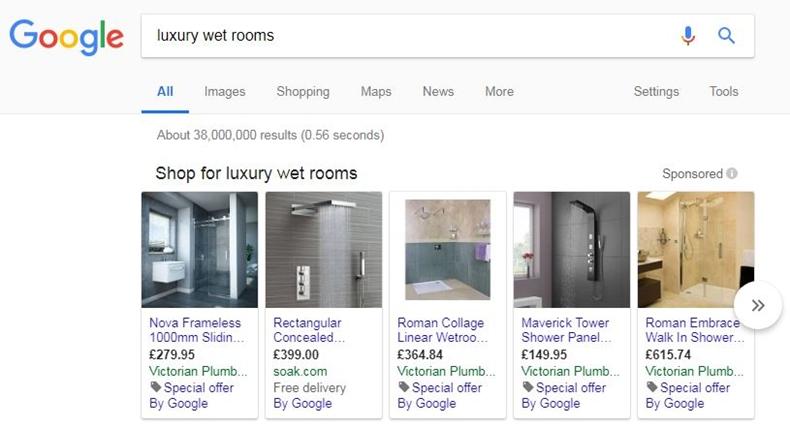But that doesn't mean that SEO strategies are one-size-fits-all. The terms you want to rank for are also terms that e-commerce sites rank for; so, instead of your B2B service, Google Shopping widgets and online stores dominate the search results. For example: Your company designs and fits wet rooms for large commercial projects and new construction, such as hotels and high-rise apartment buildings; so, you want to target architects, developers, and consultants involved in big building projects... but many of your best keywords return results like this: E-commerce search results can confuse B2B searchers, at which point one of two things will happen: (1) You lose website traffic because you're appearing so lower down the page than you otherwise would; (2) The traffic you get isn't the traffic you want, because they're B2C customers who will never convert. You need to use your traffic effectively, position yourself correctly for search, create the right content, and make sure that you have relevant converting actions. Use your traffic effectively Of course, not all traffic is good: You want the people who land on your service pages to be as likely to convert as possible. would likely not result in the conversion you're looking for, the amount of traffic it gets from B2C searchers adds authority to your site and sends positive ranking signals to Google. Create the right content Like your title tags and meta descriptions, your on-site content needs to clearly communicate a B2B offering. Create content that your target audience will value. Calls to action that encourage people to further explore your offering, such as a video or a case study, allow you to demonstrate the nature of your business offering. B2B search marketing is all about understanding the nuances of your end customer and where to ideally place your brand in order to convert that customer.
We all know that our search engine optimization (SEO) efforts must adhere to some fundamentals. But that doesn’t mean that SEO strategies are one-size-fits-all. In fact, one of the most challenging situations for B2B digital marketers is to have their business buried among search results that are B2C-focused.
The Problem
You have a business that specializes in providing a B2B product or service, but all of your keyword search terms return results that are B2C. The terms you want to rank for are also terms that e-commerce sites rank for; so, instead of your B2B service, Google Shopping widgets and online stores dominate the search results.
The result? High bounce rate, irrelevant traffic, and low conversion percentages.
This phenomenon is not uncommon across various industries, but it is prevalent in construction, where do-it-yourself (DIY) and professional design collide. For example: Your company designs and fits wet rooms for large commercial projects and new construction, such as hotels and high-rise apartment buildings; so, you want to target architects, developers, and consultants involved in big building projects… but many of your best keywords return results like this:

E-commerce search results can confuse B2B searchers, at which point one of two things will happen: (1) You lose website traffic because you’re appearing so lower down the page than you otherwise would; (2) The traffic you get isn’t the traffic you want, because they’re B2C customers who will never convert.
So, how do you make your business attract the right kind of audience?
The Solution
The simple solution is to have a very specific strategy. The tricky part is its execution. You need to use your traffic effectively, position yourself correctly for search, create the right content, and make sure that you have relevant converting actions.
Let’s take those one at a time.
Use your traffic effectively
Of course, not all traffic is good: You want the people who land on your service pages to be as likely to convert as possible. But, at the same time, getting lots of traffic from a variety of sources is an important ranking factor for Google. So how do we square this circle?
You don’t want to reduce your traffic. Instead, divert it to the right places. Send your target audience to your service pages, and send the B2C traffic elsewhere.
Make your key converting pages target extremely specific, longtail keywords. Sure, the traffic may be miniscule, but because its hyper-specific you can rest assured that the few visitors you do get to the page will be much…
COMMENTS